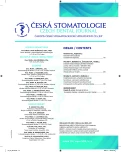Ectodermal dysplasia
Authors:
L. Kramerová; E. Kaplová
Authors‘ workplace:
Klinika zubního lékařství LF UP a FN, Olomouc
Published in:
Česká stomatologie / Praktické zubní lékařství, ročník 113, 2013, 5, s. 115-119
Category:
Review Article
Věnováno prof. MUDr. Martině Kukletové, CSc., k významnému životnímu jubileu
Overview
Background:
Ectodermal dysplasia is a rare, genetically determined disease, which is characterized by alterations in two or more ectodermal structures, at least one of these involving alterations in hair, teeth, nails, or sweat glands. It is estimated that about seven in 10 000 births are affected with a form ectodermal dysplasia. The cause of the disease is mutation of genes, which can be found in Eda/NF-KB (nuclear factor kappa B) pathway. We recognize two main forms of the disease: hypohidrotic ectodermal dysplasia and hidrotic ectodermal dysplasia. Most cases of hypohidrotic ectodermal dysplasia are related to the sex and caused by the mutation in EDA with gene localization Xq12-q13.1. Lower number of cases is autosomally recessive or dominant with the mutation in EDAR or EDARADD with gene localizations 1q42.2-q43 or 2q11-q13. The small subclass is sex related recessive hypohidrotic ectodermal dysplasia with immunodeficiency. It relates to the IKK-gamma gene mutations which encodes nuclear factor-kappaB essential modulator (NEMO) with the gene localization is Xq28. Hypohidrotic ectodermal dysplasia is characterized by hypotrichosis (sparseness of scalp and body hair), hypohidrosis (reduced ability to sweat), and hypodontia (tooth agenesis). In the X-linked recessive form of hypohidrotic ectodermal dysplasia, males are usually more severely affected, and females show variable severity, ranging from mild to severe. The most characteristic findings in man are the reduced number and abnormal shape of teeth. The scalp hair is thin, lightly pigmented, and slow-growing. Skin is thin, glossy, smooth, and dry with hypohidrosis. Another type is autosomally dominant hidrotic ectodermal dysplasia, Clouston syndrome with the gene localization 13q12. In contrast to the above described hypohidrotic ectodermal dysplasia ED1, the normal function of sweat and sebaceous glands is maintained.
Key words:
ectodermal dysplasia – hypohidrosis – hypotrichosis – hypodontia – Eda/NF-KB pathway
Sources
1. Aschenbrennerová, E., Lošan, F., Šubrtová, I.: Familiární výskyt anhydrotické ektodermální dysplazie. Kasuistika. Čes. Stomat., roč. 92, 1992, č. 2/3, s. 133–139.
2. Bulut, E., Guler, A. U., Sen Tunc, E., Telcioglu, N. T.: Oral rehabilitation with endosseous implants in a child with ectodermal dysplasia: a case report. Eur. J. Pediatr. Dent., roč. 11, 2010, č. 3, s. 149–152.
3. Dort, J., Fabianová, J., Lošan, F.: Anhidrotická ektodermalní dysplazie. Čs. Pediat., roč. 39, 1984, č. 11, s. 659–661.
4. Fára, M.: Sdružené vrozené vady hlavy jako projevy regionální ektodermální dysplazie. Čs. Pediat., roč. 26, 1971, č. 11, s. 547–549.
5. Fleischmannová, J., Krejčí, P., Matalová, E., Míšek, I.: Molekulární podstata vývoje zubních zárodků. Ortodoncie, roč. 16, 2007, č. 4, s. 39–46.
6. Freire Maia, N.: Ectodermal dysplasias. Hum. Hered., 1971, č. 21, s. 309–312.
7. Freire Maia, N.: Ectodermal dysplasias revisited. Acta Genet. Med. Gemellol., 1977, č. 26, s. 121–131.
8. Freire Maia, N, Pinheiro, M.: Ectodermal dysplasias: A clinical and genetic study. New York, Alan R. Liss., 1984, s. 251.
9. Krejčí, P.: Hypodoncie. Souborný referát. Ortodoncie, roč. 15, 2006, č. 3, s. 21–29.
10. Krejčí, P., Fleischmannová, J., Matalová, E., Míšek, I.: Molekulární podstata hypodoncie. Ortodoncie, roč. 16, 2007, č. 1, s. 33–39.
11. Lamartine, J.: Towards a new classification of ectodermal dysplasias. Clin. Exp. Dermatol., 2003, č. 28, s. 351–355.
12. Mikkola, M. L.: Molecular aspects of Hypohidrotic ectodermal dysplasia. Am. J. Med. Genet., 2009, Part A 149A, s. 2031–2036.
13. Mortier, K., Wackens, G.: Ectodermal dysplasia anhidrotic. Orphanet Encyclopedia, September 2004, http://www.orpha.net/data/patho/GB/uk-ectodermal-dysplasia-anhidrotic.pdf.
14. Priolo, M., Laganà, C.: Ectodermal dysplasias: A new clinical-genetic classification. J. Med. Genet., 2001, č. 38, s. 579–585.
15. Priolo, M., Silengo, M., Lerone, M., Ravazzolo, R.: Ectodermal dysplasias: Not only ‘skin’ deep. Clin. Genet., 2000, č. 58, s. 415–430.
16. Prachár, P., Bartáková, S., Černochová, P., Kuklová, J., Vaněk, J.: Ektodermální dysplazie – souvislosti a implantace. Čes. Stomat., roč. 109, 2009, č. 6, s. 106–111.
17. Rothschild, L., Jorda, V., Růžička, J.: Ektodermální dysplazie u dvojčat. Čs. Derm., roč. 42, 1967, č. 4, s. 224–228.
18. Rüdiger, R. A., Haase, W., Passarge, E.: Association of ectrodactyly, ectodermal dysplasia, and cleft lip-palate. Am. J. Dis. Child., roč. 2, 1970, č. 120, s. 160–163.
19. Simeonsson, R. J.: Classifying Functional Manifestations of Ectodermal Dysplasias. Am. J. Med. Genet., 2009, Part A 149A, s. 2014–2019.
20. Tichá, B.: Hypodoncie a ektodermální dysplazie. Čes. Stomat., roč. 64, 1964, č. 2, s. 139–143.
21. Visinoni, A. F., Lisboa-Costa, T., Pagnan, N. A. B., Chautard-Freire-Maia, E. A.: Ectodermal dysplasias: Clinical and molecular review. Am. J. Med. Genet., 2009, Part A 149A, s. 1980–2002.
22. Wright, J. T., Grange, D. K., Richter, M. K.: Hypohidrotic ectodermal dysplasia. In GeneReviews. Pagon, R. A., Bird, T. D., Dolan, C. R., Stephens, K., Adam, M. P. (eds.), University of Washington, Seattle, December 2011, http://www.ncbi.nlm.nih.gov/books/NBK1112/.
23. http://www.omim.org/.
Labels
Maxillofacial surgery Orthodontics Dental medicineArticle was published in
Czech Dental Journal

2013 Issue 5
Most read in this issue
- Ectodermal dysplasia
- Functional Foods and Functional Food Components in Prevention of Dental Karies
- Dental Implantology in the Treatment of the After-Effects of the Juvenile Paresis Nervus Facialis
- Stomatological Problems in Child with the II Type Mucopolysaccharidosis
